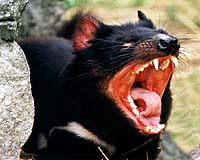| . |  |
. |
Calgary, Canada (SPX) Sep 17, 2010 What, in nature, drives the incredible diversity of flowers? This question has sparked debate since Darwin described flower diversification as an 'abominable mystery.' The answer has become a lot clearer, according to scientists at the University of Calgary whose research on the subject is published in the on-line edition of the journal Ecology Letters. Drs. Jana Vamosi and Steven Vamosi of the Department of Biological Sciences have found through extensive statistical analysis that the size of the geographical area is the most important factor when it comes to biodiversity of a particular flowering plant family. The researchers were looking at the underlying forces at work spurring diversity - such as why there could be 22,000 varieties of some families of flowers, orchids for example, while there could be only forty species of others, like the buffaloberry family. In other words, what factors have produced today's biodiversity? "Our research found that the most important factor is available area. The number of species in a lineage is most keenly determined by the size of the continent (or continents) that it occupies," says Jana Vamosi. Steven Vamosi adds that while the findings of this research mostly shed light on what produces the world's diversity, it may comment on what produces extinction patterns as well. "The next step is to determine if patterns of extinction risk mirror those observed for diversification, specifically to contrast the relative influence of available area and traits," he says. Typically, when it comes to explaining the biodiversity of flowering plants, biologists' opinions fall into three different camps: family traits (for example a showy flower versus a plain flower), environment (tropic versus arid climate) or sheer luck in geography (a seed makes it way to a new continent and expands the geographical range of a family). But the Vamosi research demonstrates that geography isn't the only answer, traits of the family came in a close second to geography. Traits that may encourage greater diversity are known as "key innovations" and scientists have hypothesized that some families possess more species because they are herbs, possess fleshy fruits (such as an apple or peach), or that their flowers have a more complex morphology. Zygomorphy (or when a flower can only be divided down the middle to make two equal mirror images) is thought to restrict the types of pollinators that can take nectar and pollen from the flower. Flies, for instance, won't often visit zygomorphic flowers. Bees, on the other hand, adore them. "Although geography may play a primary role, a close second is the flower morphology of the plants in a particular family," says Jana Vamosi. "So essentially all camps may claim partial victory because morphological traits should be considered in the context of geographical area."
Share This Article With Planet Earth
Related Links University of Calgary Darwin Today At TerraDaily.com
 Genome breakthrough for cancer-hit Tasmanian Devils
Genome breakthrough for cancer-hit Tasmanian DevilsSydney (AFP) Sept 16, 2010 Australian scientists Thursday said they had made a breakthrough in the fight to save the cancer-hit Tasmanian devil by mapping the species' genome for the first time. The dark, furry marsupials were declared endangered in 2009 after a contagious cancer began sweeping through the population, disfiguring their faces so badly they are unable to eat and starve to death. Some 70 percent of d ... read more |
|
| The content herein, unless otherwise known to be public domain, are Copyright 1995-2010 - SpaceDaily. AFP and UPI Wire Stories are copyright Agence France-Presse and United Press International. ESA Portal Reports are copyright European Space Agency. All NASA sourced material is public domain. Additional copyrights may apply in whole or part to other bona fide parties. Advertising does not imply endorsement,agreement or approval of any opinions, statements or information provided by SpaceDaily on any Web page published or hosted by SpaceDaily. Privacy Statement |